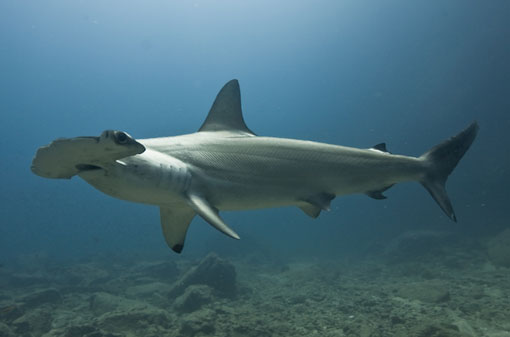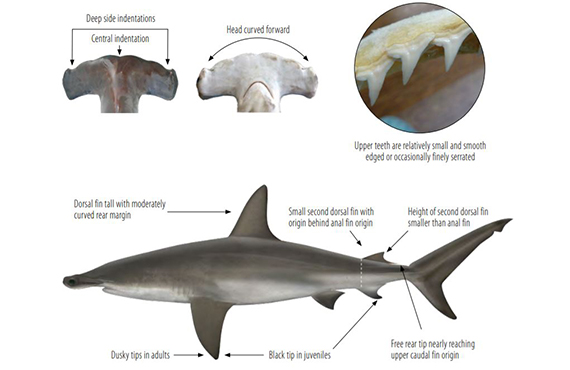
Scalloped Hammerhead Shark

Scientific name
Sphyrna lewini
Status in NSW
Endangered.
Characteristics
The Scalloped Hammerhead Shark can be distinguished by their large flattened 'hammer-like' head, with wide set eyes and prominent central scallop-like indentation in the front margin of the head. The Scalloped Hammerhead Shark has a tapered shape, with light brown, bronze or olive colouring on the dorsal surfaces, fading to white below. The underside of the pectoral fin tips has a dusky colouration.
Species similar in appearance
The Scalloped Hammerhead Shark is often confused with other species of hammerhead sharks, including the Smooth Hammerhead and the Great Hammerhead shark. On Scalloped Hammerheads the narial groove that occurs on the underside of the head is shorter and less developed, while the central scallop is usually more prominent and well developed than on the Smooth Hammerhead. The teeth of the Scalloped Hammerhead are also usually smooth edged, while the Smooth Hammerhead usually has weakly serrated teeth.
Size
Up to 3.5 metres in length, although there are unconfirmed reports of larger individuals.
Distribution
The Scalloped Hammerhead Shark has a circumglobal distribution in tropical and warm temperate seas between 45°N to 34°S, but occurs more frequently at higher latitudes during the warmer months. Scalloped Hammerheads may be found throughout the seas around northern Australia as far south as Sydney, NSW (34°S) and Geographe Bay WA (33°S).
Habitat
Adult Scalloped Hammerhead Sharks inhabit deep waters adjacent to continental shelves, in water depths ranging from the surface to at least 275 in depth, while juveniles are found close to shore. Adult females are thought to occupy deeper water and move into shallower waters to mate and give birth.
Why is the Scalloped Hammerhead Shark threatened?
- Commercial, recreational and shark meshing bather protection fisheries are the primary threats to the Scalloped Hammerhead Shark.
- Globally, adults are susceptible to long-lining and gillnetting operations due to their pelagic nature. Juveniles are susceptible to most fishing methods in inshore waters and pups are impacted by prawn trawling and recreational fishing in nursery areas.
- Scalloped Hammerhead Sharks have been taken for their meat and high value fins, and have been subject to illegal, unregulated and unreported fishing in northern Australia over the last decade.
- Slow growth and late maturation reduces the potential for quick recovery of the species.
More information
- Fisheries Scientific Committee final determination (November 2011) (PDF, 56.02 KB)
- Hammerhead Sharks in NSW – A guide for fishers
- Hammerhead Sharks in NSW – Frequently Asked Questions
- Identifying sharks and rays - A guide for NSW commercial fishers
- Infographic - Identification guide for Hammerhead Sharks in NSW
- Primefact: Scalloped Hammerhead Shark (Sphyrna lewini)
- Priorities Action Statement - Actions for Scalloped Hammerhead Shark


